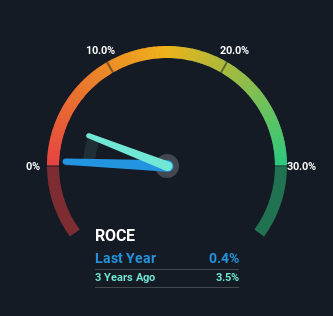Returns On Capital Signal Tricky Times Ahead For Bannari Amman Spinning Mills (NSE:BASML)
What are the early trends we should look for to identify a stock that could multiply in value over the long term? Amongst other things, we'll want to see two things; firstly, a growing return on capital employed (ROCE) and secondly, an expansion in the company's amount of capital employed. Ultimately, this demonstrates that it's a business that is reinvesting profits at increasing rates of return. Although, when we looked at Bannari Amman Spinning Mills (NSE:BASML), it didn't seem to tick all of these boxes.
Understanding Return On Capital Employed (ROCE)
For those that aren't sure what ROCE is, it measures the amount of pre-tax profits a company can generate from the capital employed in its business. To calculate this metric for Bannari Amman Spinning Mills, this is the formula:
Return on Capital Employed = Earnings Before Interest and Tax (EBIT) ÷ (Total Assets - Current Liabilities)
0.0041 = ₹33m ÷ (₹13b - ₹4.7b) (Based on the trailing twelve months to June 2023).
Therefore, Bannari Amman Spinning Mills has an ROCE of 0.4%. In absolute terms, that's a low return and it also under-performs the Luxury industry average of 10%.
See our latest analysis for Bannari Amman Spinning Mills

Historical performance is a great place to start when researching a stock so above you can see the gauge for Bannari Amman Spinning Mills' ROCE against it's prior returns. If you're interested in investigating Bannari Amman Spinning Mills' past further, check out this free graph of past earnings, revenue and cash flow.
So How Is Bannari Amman Spinning Mills' ROCE Trending?
On the surface, the trend of ROCE at Bannari Amman Spinning Mills doesn't inspire confidence. To be more specific, ROCE has fallen from 11% over the last five years. Given the business is employing more capital while revenue has slipped, this is a bit concerning. If this were to continue, you might be looking at a company that is trying to reinvest for growth but is actually losing market share since sales haven't increased.
On a side note, Bannari Amman Spinning Mills has done well to pay down its current liabilities to 37% of total assets. So we could link some of this to the decrease in ROCE. Effectively this means their suppliers or short-term creditors are funding less of the business, which reduces some elements of risk. Since the business is basically funding more of its operations with it's own money, you could argue this has made the business less efficient at generating ROCE.
Our Take On Bannari Amman Spinning Mills' ROCE
We're a bit apprehensive about Bannari Amman Spinning Mills because despite more capital being deployed in the business, returns on that capital and sales have both fallen. Long term shareholders who've owned the stock over the last five years have experienced a 25% depreciation in their investment, so it appears the market might not like these trends either. Unless there is a shift to a more positive trajectory in these metrics, we would look elsewhere.
Since virtually every company faces some risks, it's worth knowing what they are, and we've spotted 3 warning signs for Bannari Amman Spinning Mills (of which 2 are potentially serious!) that you should know about.
While Bannari Amman Spinning Mills isn't earning the highest return, check out this free list of companies that are earning high returns on equity with solid balance sheets.
Valuation is complex, but we're here to simplify it.
Discover if Bannari Amman Spinning Mills might be undervalued or overvalued with our detailed analysis, featuring fair value estimates, potential risks, dividends, insider trades, and its financial condition.
Access Free AnalysisHave feedback on this article? Concerned about the content? Get in touch with us directly. Alternatively, email editorial-team (at) simplywallst.com.
This article by Simply Wall St is general in nature. We provide commentary based on historical data and analyst forecasts only using an unbiased methodology and our articles are not intended to be financial advice. It does not constitute a recommendation to buy or sell any stock, and does not take account of your objectives, or your financial situation. We aim to bring you long-term focused analysis driven by fundamental data. Note that our analysis may not factor in the latest price-sensitive company announcements or qualitative material. Simply Wall St has no position in any stocks mentioned.
About NSEI:BASML
Bannari Amman Spinning Mills
Engages in the textile business in India and internationally.
Acceptable track record with mediocre balance sheet.
Similar Companies
Market Insights
Community Narratives




